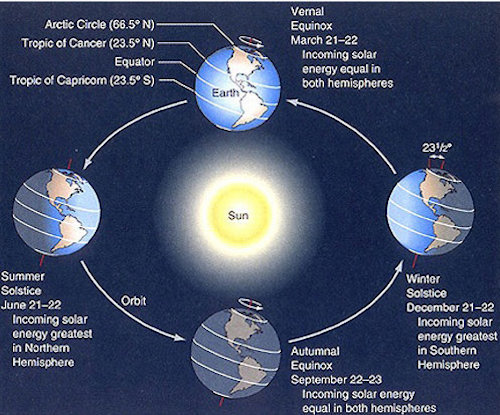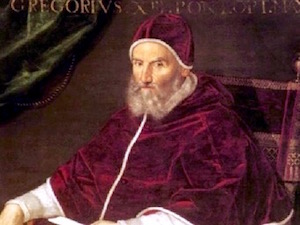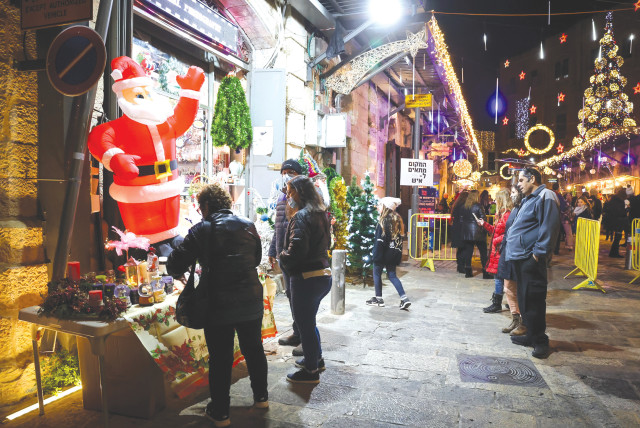The Seven Day Week The fixed 7-day week is so much a part of daily life that it is commonly assumed to be as old as human society. It is not known for sure when the system of fixed 7-day weeks, with no relation to the lunar cycle, came into use, but probably lie in Sumerian/Babylonian culture. Some Historians believe that around 2350BC. Sargon I, King of Akkad, having conquered Ur and the other cities of Sumeria, instituted a seven-day week, the first to be recorded. The Jews were commanded to observe "the seventh day" as one on which no work was to be performed (in contrast to the other days when work was done). If this is understood as every seventh day (rather than the seventh day of some period such as the month) then a sequence of fixed 7-day weeks emerges. The fixed 7-day week was not widely used until it was introduced into the Julian Calendar in the 4th Century CE by the Emperor Constantine. Through accidents of history, the Gregorian Calendar has come to be used worldwide as the standard civil calendar for government and business affairs. No improvement has been made in this calendar since it was decreed by Pope Gregory in 1582. Although some forms of life exhibit cycles of 29-30 days (influenced by the Moon) there is no naturally occurring cycle of seven days. In human society at present this cycle runs on continuously but it has no harmonious relation with the other units of time, the month and the year. The 7-day week exists solely because of social habit and religious tradition, with otherwise no justification. The synodic month (a.k.a. the mean lunar month) is the mean (that is, average) interval in days between exact conjunctions of the Moon and the Sun (as observed from the Earth). The current value of the synodic month (rounded to six decimal places) is 29.530588 days. The story of Noah contains many allusions to seven days. Note the following in Chapters 7 and 8 of Genesis:
Do Weeks of Different Lengths Exist?If you define a "week" as a 7-day period, obviously the answer is no. But if you define a "week" as a named interval that is greater than a day and smaller than a month, the answer is yes In international standard ISO-8601 the International Organization for Standardization (ISO) has decreed that Monday shall be the first day of the week. The Lunar Year | ||||||||||||||||||||||||||||||||||||||||||||||||||||||||||||||||||||||
Most calendars are based on the solar year. Solar years have the disadvantage of not being easily observable. Many years of observations are required to fix them with any significant degree of accuracy. On the other hand, the phases of the Moon -- and the first visibility after the new moon in particular -- are very easy and quick to observe. Therefore, the first calendars defined a lunar year, usually consisting of 12 synodic months. A synodic month is the interval from one new moon to the next and lasts 29.530588 days. This is equivalent to 29 days, 12 hours, 44 minutes and 2.9 seconds. Since for practical reasons a month should contain an integer number of days, most calendars alternated between months of 29 and 30 days, respectively. A year made out of six months of each type has 354 days and is thus too short by 0.3672 days as compared with a true lunar year. Therefore lunar calendars have to insert one leap day about every third year to keep in step with the moon phases. A pure lunar calendar is not synchronous with the seasons and after 16 years will put the winter in the summer and vice versa. Over a period of 32 years it will cycle through a complete year.The Luni-Solar YearA luni-solar year is the attempt to combine the phases of the moon and the seasons into one calendar. This is possible if leap months are inserted. Several schemes were used in history. The best known solution was found by the Greek Meton in the year 432 BC but apparently was known to other cultures before. The Metonic cycle encompasses a total of 235 months of which 125 are full (i.e. they have 30 days) and 110 are `hollow' (having 29 days). The months are combined into 12 normal years with 12 months each and 7 leap years with 13 months each. The cycle covers 6940 days whereas 225 synodic months sum up to 6939.688 days and 19 tropical years to 6939.602 days. The difference in motion between Sun and Moon amounts to only 0.0866 days so that eclipses repeat in the Metonic cycle with high accuracy. No correction applied The Hebrew CalendarThe year is divided into 12 lunar months which each start when the new moon is first visible. This gives a total of approx 354 days. The result of this is that the entire year moves 11 or 12 days per year. This was compensated for by adding an additional month seven times in every 19 years. The names of the Jewish months are - Tishrei (formally Abib), Iyyar (formally Ziv), Sivan, Tammuz, Av, Elul, Tishri (formally Ethanim), Marchesvan (Bul), Kislev, Tebet, Shebat and Adar. In a leap year Adar I is followed by Adar II. The months of Marchesvan and Kislev vary in length to make the year length correct. The new year starts on the first day of the first new moon after the vernal equinox. However there are some days of the week on which the year cannot start as certain holidays cannot precede or succeed the Sabbath. This means that some years a day is added, or removed, to ensure that the day/date rules are abided by. An ordinary year consists of 353, 354 or 355 days. A leap year consists of 383, 384 or 385 days. These three lengths of each type of year are known as 'deficient', 'regular' and 'complete' years.
| ||||||||||||||||||||||||||||||||||||||||||||||||||||||||||||||||||||||
| September 1752 To make the weeks work out, eleven days were subtracted and three real days were eliminated to make this adjustment, which puts our calendar out of sync with time measured prior to this change. Count the days. | |||||||||||||
| Su | M | Tu | W | Th | F | Sa | |||||||
| &; | &; | 1 | 2 | 14 | 3 | 15 | 4 | 16 | 5 | ||||
| 17 | 6 | 18 | 7 | 19 | 8 | 20 | 9 | 21 | 10 | 22 | 11 | 23 | 12 |
| 24 | 13 | 25 | 26 | 27 | 28 | 29 | 30 | ||||||
link article: How Britain got the Calendar Wrong
Greece: 9 Mar 1924 was followed by 23 Mar 1924
Hungary: 21 Oct 1587 was followed by 1 Nov 1587
Italy: 4 Oct 1582 was followed by 15 Oct 1582
Japan: Different authorities say:
19 Dec 1872 was followed by 1 Jan 1873
18 Dec 1918 was followed by 1 Jan 1919
Latvia: During German occupation 1915 to 1918
Lithuania: 1915
Luxembourg: 14 Dec 1582 was followed by 25 Dec 1582
Netherlands:
Brabant, Flanders, Holland, Artois, Hennegau:
14 Dec 1582 was followed by 25 Dec 1582
Geldern, Friesland, Zeuthen, Groningen, Overysel:
30 Nov 1700 was followed by 12 Dec 1700
Norway: Then part of Denmark.
Poland: 4 Oct 1582 was followed by 15 Oct 1582
Portugal: 4 Oct 1582 was followed by 15 Oct 1582
Prussia : 22 Aug 1610 was followed by 2 Sept 1610
Romania: 31 Mar 1919 was followed by 14 Apr 1919
Russia: 31 Jan 1918 was followed by 14 Feb 1918
Spain: 4 Oct 1582 was followed by 15 Oct 1582
Sweden (including Finland):
17 Feb 1753 was followed by 1 Mar 1753 (see note below)
Switzerland:
Catholic cantons: 1583 or 1584
Zurich, Bern, Basel, Schafhausen, Neuchatel, Geneva:
31 Dec 1700 was followed by 12 Jan 1701
St Gallen: 1724
Transylvania : 14 Dec 1590 was followed by 25 Dec 1590
Turkey: 18 Dec 1926 was followed by 1 Jan 1927
Tyrol : 5 Oct 1583 was followed by 16 Oct 1583
USA: See Great Britain, of which it was then a colony.
Yugoslavia: 14 January 1919 was followed by 28 January 1919
but parts of the country had changed over earlier.
Sweden has a curious history. Sweden decided to make a gradual change from the Julian to the Gregorian calendar. By dropping every leap year from 1700 through 1740 the eleven superfluous days would be omitted and from 1 Mar 1740 they would be in sync with the Gregorian calendar. (But in the meantime they would be in sync with nobody!)
So 1700 (which should have been a leap year in the Julian calendar) was not a leap year in Sweden. However, by mistake 1704 and 1708 became leap years. This left Sweden out of synchronisation with both the Julian and the Gregorian world, so they decided to go ‘back’ to the Julian calendar. In order to do this, they inserted an extra day in 1712, making that year a double leap year! So in 1712, February had 30 days in Sweden.
Later, in 1753, Sweden changed to the Gregorian calendar by dropping 11 days like everyone else.
It should be noted that the Gregorian Calendar is useless for astronomy because it has a ten-day hiatus in it. For the purpose of calculating positions backward in time, astronomers use the Julian Date Calendar.
-- source:Calendopaedia
Calendar changes over time...
The Julian calendar, introduced by Julius Caesar in 45 BC, began on 1st January, with the length of months alternating between 31 and 30 days - except for February, which had 30 days in a leap year and 29 days otherwise. (This replaced an earlier Roman calendar which had 10 months of alternating 30 and 31 days, followed by a "winter gap", the length of which varied from year to year. The last year of this old calendar actually had 445 days.)
Complications to the Julian system began when the Senate wanted to name a month after the then Emperor Augustus. To avoid slighting the Emperor, the month named for Augustus must be as long as the month named for Julius, and should follow it directly. And so July and August became 31 days each, and February surrendered an extra day. (To avoid 3 successive 31 day months, September was shortened to 30 days, October lengthened to 31, and so on.)
The Romans initially introduced leap years every 3 years, but by about 9 BC it was seen that the calendar was getting out of step with the solstices, so leap years were abandoned altogether, until about AD 4 or 8, when leap years were re-introduced as every 4 years. Even this was not completely accurate, giving an error of 45 minutes in 4 years, or 3 days in 400 years. In time, this miscalculation became quite noticeable.
Around 150 AD Christian churches decided to take over the pagan festival of Saturnalia (the winter solstice) and celebrate 25th December as Christ's birthday. Later, when the cult of the Virgin Mary became popular, it was thought that the Christian era should start on the day of Christ's conception, that is, 9 months earlier on 25th March, which they named Ladyday. The year began on 25th March and ended on the following 24th March.
All moveable feasts in the church calendar relate to Easter. In turn, gospel tradition related Easter to the Jewish festival of Passover, which in turn was related to the spring equinox, the phase of the moon and the celebration of the Sabbath. Over the centuries, by following the Julian calendar, the Easter festival was slowly but surely moving away from the spring equinox towards the summer solstice. The new system adopted by Pope Gregory in the 16th century, specified a calendar with a year length of 365 days, 5 hours, 40 minutes, 20 seconds. There
Christian ChKhomyshyn and in the 1930s in the Orthodox church in Poland were strongly opposed by the Ukrainian community and did not succeed. However, the new calendar was adopted by some Ukrainian church communities outside Ukraine, notably by the Ukrainian Catholic church in Argentina, Brazil, and some eparchies in the USA and Canada.
The two calendars differ not only on the fixed feasts, but also on the movable feasts of the Easter cycle. The dates of the latter are calculated according to the paschal period, which is based on the monthly cycle. The Eastern church uses the period introduced by Dionysius Exiguus in 525. This has been modified by the Western church as well.urch may have had “grave concerns” about the date of Easter being astronomically inaccurate on the church lunar and Julian solar calendars, but the secular world was not obligated by a papal bull. The Catholic countries of Spain, Italy, Portugal and the Polish-Lithuanian Commonwealth, however, adopted the new calendar immediately. Scotland and most Protestant countries adopted Gregory’s calendar in the 1700’s. England and colonial America adopted it in 1752. When Alaska was purchased by the United States from Russia in 1867, the Alaska Territory began to keep Gregorian time. Russia remained on the Julian calendar until 1917 after the Russian Revolution and Greece held on to Julian until 1923. Some tribes and isolated peoples still use the Julian calendar.
calendar to begin with his rule, but the Senate had always started a new year on January 1, the month named after the god Janus who had two faces, one looking ahead to the future and the other looking back to the past (right).
July1 (named after “Julius’) is not the start of our New year. January 1 and the god Janus still stands guard over his territory.
The Julian Calendar would be used for the next 1,600 years.
CLICK HERE for article on Julius Caesar and the Julian Calendar
But the Christian Church had for centuries used a different calendar for its main celebration—The Resurrection of Jesus, Easter aka Pascha (Hebrew for “Passover”). The Church Calendar, based on a lunar system, had been devised at The First Council of Nicea in 325 to ensure the Church celebrated Easter on the exact Sunday of the Resurrection. The Church in Alexandria, following a solar calendar, had always celebrated Easter on the 14th day of the moon that falls on or after the vernal (the Spring) equinox.
The earth revolves around the sun and two times each year, the sun is exactly above the equator (See below). These two times in Sept and March are equinoxes, meaning “equal night,” because the length of a day and a night is almost equal in all parts of the world at those two times. By the 900’s most Christian churches celebrated Easter according to the Alexandrine method. But the vernal equinox drifts. When Julius Caesar established his calendar in 45 BC he set March 25 as the spring equinox. Because a Julian year (365.25 days) is slightly longer than the tropical year, the calendar “drifted” with respect to the equinox such that the equinox was occurring on about March 21 in AD 300 and by AD 1500 it had reached March 11. By the 1500’s both the Church’s lunar calendar and the Julian calendar were off kilter and Easter was being celebrated on the wrong day.
By the 900’s most Christian churches celebrated Easter according to the Alexandrine method. But the vernal equinox drifts. When Julius Caesar established his calendar in 45 BC he set March 25 as the spring equinox. Because a Julian year (365.25 days) is slightly longer than the tropical year, the calendar “drifted” with respect to the equinox such that the equinox was occurring on about March 21 in AD 300 and by AD 1500 it had reached March 11. By the 1500’s both the Church’s lunar calendar and the Julian calendar were off kilter and Easter was being celebrated on the wrong day.
 Pope Gregory XIII (left) and the learned ecclesiastics were determined to fix the problem of equinox drift and the confusion over the date of Easter once and for all. To remedy “the drift problem,” the Gregorian calendar dropped 10 days from the year 1582. On Thursday October 4, 1582 the Church adopted what would be called the Gregorian calendar by a papal bull entitled Inter Gravissimas (”Among The Greatest Concern”).
Pope Gregory XIII (left) and the learned ecclesiastics were determined to fix the problem of equinox drift and the confusion over the date of Easter once and for all. To remedy “the drift problem,” the Gregorian calendar dropped 10 days from the year 1582. On Thursday October 4, 1582 the Church adopted what would be called the Gregorian calendar by a papal bull entitled Inter Gravissimas (”Among The Greatest Concern”).

The Christian Church may have had “grave concerns” about the date of Easter being astronomically inaccurate on the church lunar and Julian solar calendars, but the
The Julian calendar was not established in smooth operation until 8 CE, but eventually, Rome moved away from the Julian calendar in favour of the Gregorian Calendar. In the transition to the Gregorian calendar, some days were dropped to synchronise with astronomical events such as the vernal equinox and the winter solstice. The papal bull issued by Pope Gregory XIII in 1582 decreed that ten days be dropped unless the switch occurred later, which would result in more days being dropped.
The move to the Gregorian Calendar
| Year of Switch | Country | Days Removed |
|---|---|---|
| 1582 | France (most areas), Italy, Poland, Portugal, Spain | 10 days |
| 1583 | Austria, Germany (Catholic states) | 10 days |
| 1587 | Hungary | 10 days |
| 1610 | Germany (Prussia) | 10 days |
| 1700 | Germany (Protestant areas), Switzerland (Protestant areas) | 10 days |
| 1752 | United States (most areas), Canada (most areas), United Kingdom (and colonies) | 11 days |
| 1872/1873 | Japan | 12 days |
| 1916 | Bulgaria | 13 days |
| 1918 | Estonia, Russia | 13 days |
| 1923 | Greece | 13 days |
| 1926/1927 | Turkey | 13 days |
The list includes only a small selection of countries. In some cases, it shows a simplified version of events. Countries are listed by their current names although their official name may have changed since the calendar reform.
Disqualifying the Gregorian Calendar as the Bible Calendar
Surprisingly the disqualification of the Gregorian calendar as the Bible calendar is easy as long as one is willing to do some investigation. The following proof shows why the Gregorian calendar does not and could not match the biblical calendar.

Proof #1: Days removed from the Gregorian calendar
Several days were removed from the Gregorian calendar, enabling the transition from the Julian calendar. Let’s consider the weekly seven-day cycle with the seventh day as a Sabbath and assume the Julian and biblical calendar are the same. The new calendar will be out of sync with the weekly rotation as the seven-day rule has been compromised. The Sabbath falls on the seventh day of the week, so unless the number of days removed is a multiple of seven, it’s impossible to maintain equilibrium.
It is unlikely that the Julian calendar is the Hebrew calendar, and the argument could be put forward that the Gregorian calendar was being synchronised with the Hebrew Calendar, but this is not the reason put forward by Rome. Israel as a subordinate state commanded no say in how the Roman empire was run.
47. Then gathered the chief priests and the Pharisees a council, and said, What do we? for this man doeth many miracles.
48. If we let him thus alone, all men will believe on him: and the Romans shall come and take away both our place and nation.
John 11:47-48
Proof #2: Gregorian = Egyptian solar calendar
The Gregorian calendar transitioned from the Julian calendar (based on the Egyptian calendar) to the Roman Civic/Republic calendar (possibly based on the Greek lunar calendar). Nowhere in this equation is the Hebrew calendar reckoned. To start, a politically manipulated Roman Civic calendar and then a solar-cycle Egyptian calendar (Julian and Gregorian calendars). The scriptural evidence suggests that the biblical calendar uses both the sun and the moon to determine the time and date, which neither lunar nor solar calendars satisfy.
14. And God said, Let there be lights in the firmament of the heaven to divide the day from the night; and let them be for signs, and for seasons, and for days, and years:
15. And let them be for lights in the firmament of the heaven to give light upon the earth: and it was so.
Genesis 1:14-15 (KJV)
Proof #3: Rulers vs Subjects
The Roman kingdom directly conquered the Grecian kingdom—not the Hebrew kingdom. This conquest of the Hebrew nation resulted from Israel’s existing subjection to the Grecian rule. There would be no reason to support a Hebrew calendar for a subordinate nation, one of many nations under Grecian dominance. Before Grecian power, the Persian and Babylonian kingdoms had dominion over Israel. These rulerships can be seen in the four kingdoms of the book of Daniel, which played out exactly as written.
Proof #4: Different start of the year
The start of the Gregorian calendar year is January 1st, with a repeating twelve-monthly cycle and seven-day weekly cycle. While the monthly and weekly cycle lengths match with the Hebrew calendar, the start of the year, the length of the months, and the year-to-year rolling week do not. These aspects of the Hebrew calendar are all explored in the scriptural calendar series.
Based on when the calendar started, that would establish the first day of the week. Since the two calendars begin on different dates, their weekly cycles would have to be synced unless they coincidentally matched at the start.
Proof #5: Rolling week Gregorian calendar
The premise that for anyone to start keeping the Sabbaths, feast days, new moons, etc., without having to be a scholar in calendar history is at the heart of scriptural timekeeping. The sun, moon and stars are visible for signs and seasons. God has pinned the holy days, Sabbaths and feast days to the start of the year and the beginning of the months.
The Passover is pinned to the fourteenth day and consequently must be a Sabbath since it is on a day which is a multiple of seven counting from day one. By using numbered days instead of named days, the Bible calendar ensures the named-day method doesn’t interfere with its system; the fourteenth day cannot be confused with any other. The Gregorian calendar starts every week on Sunday; therefore, Saturday is the seventh day, but since the start of the year is not guaranteed to be a Sunday, the fourteenth day in the Gregorian Calendar cannot be the Passover since the Passover also must be a Sabbath, which is Saturday in the Gregorian calendar.
In the fourteenth day of the first month at even is the LORD’s passover.
Leviticus 23:5 (KJV)
Observe the month of Abib, and keep the passover unto the LORD thy God: for in the month of Abib the LORD thy God brought thee forth out of Egypt by night.
Deuteronomy 16:1 (KJV)
Conclusion
The evidence shows that the Gregorian calendar falls short in many places and does not even come close to the scriptural calendar. The idea of using a solar or lunar calendar has also been eliminated, with the Greeks using a lunar and the Egyptians using a solar one. The scriptures advocate that all the luminaries power the calendar; therefore, the biblical calendar must include all the luminaries (sun, moon & stars).
The Gregorian calendar was first introduced in 1582, and it took more than 300 years for all the countries worldwide, give or take, to adopt it. This calendar, also known as the Western or Christian Calendar, replaced the Julian Calendar because it did not satisfy the “science” in reflecting the time it takes the earth to circle the sun—known as the tropical year. The Julian calendar reformed the Roman republican calendar but was later replaced because the formula used to calculate leap years was inaccurate.
The Pagan Calendar in use on the Roman Catholic continent of Europe and the Mediterranean Sea lands during the “Dark Ages” was called the Julian calendar and was created by that famous pagan, sun worshiping Roman dictator, Julius Caesar; a devotee of Sol Invicta Mithras and also Jupiter, the Roman Solar deities. This calendar received the blessings of all the Roman Catholic Popes and their pagan church until it was mathematically “corrected” during the reign of Pope Gregory in 1585. The changes were mathematical and minimal in scope and encompassed the additional “changing of days and seasons” in defiance of scripture. The Pagan prosperity sungod names that Julius Caesar gave to days, weeks and months remained intact by Pope Gregory and will be discussed later in this article. These calendars worked well for the Anti-Israel and Anti-nomian, sun worshiping Babylonian Papal system, which had successfully divorced the Christian church from its Hebrew roots and created a new man made religion called Catholicism [Universal, they hoped]. This religion followed Babylon and is correctly named, “The Second Babylon”. Read Alexander Hyslop’s book of the same name, published in the 1850’s. It is excellent and correctly describes Christianity’s descent into Entropy and semi-paganism
The idea that Christians chose to celebrate the birth of Jesus on 25 December because this was the date of an already existing festival of Sol Invictus Mithra was expressed in an annotation to a manuscript of a work by 12th-century Syrian bishop Jacob Bar-Salibi. The scribe who added it wrote: “It was a custom of the Pagans to celebrate on the same 25 December the birthday of the Sun, at which they kindled lights in token of festivity. In these solemnities and revelries the Christians also took part. Accordingly when the doctors of the Church perceived that the Christians had a leaning to this festival, they took counsel and resolved that the true Nativity should be solemnized on that day.”
The Biblical day always begins at sunset as defined at creation in Genesis, while the Gregorian Catholic day begins at midnight, which figures because that hour is called in history as the “witching hour”. Go figure!
The following descriptives contain some mind-blowing facts that you never knew before and that may be damaging to your former complacency on these matters!
Now we will define each day of the week:
1] Day 1 is called as such by Yahweh. It is called by pagans as SUN-DAY; so named for the “day of the venerable sun”. The sungod, “Sol Invicta” is called Nimrod, Tammuz
. The original goal of the Gregorian calendar was to change the date of Easter.
In 1582, when Pope Gregory XIII introduced his Gregorian calendar, Europe adhered to the Julian calendar, first implemented by Julius Caesar in 46 B.C. Since the Roman emperor’s system miscalculated the length of the solar year by 11 minutes, the calendar had since fallen out of sync with the seasons. This concerned Gregory because it meant that Easter, traditionally observed on March 21, fell further away from the spring equinox with each passing year.
2. Leap years don’t really occur every four years in the Gregorian calendar.
The Julian calendar included an extra day in February every four years. But Aloysus Lilius, the Italian scientist who developed the system Pope Gregory would unveil in 1582, realized that the addition of so many days made the calendar slightly too long. He devised a variation that adds leap days in years divisible by four, unless the year is also divisible by 100. If the year is also divisible by 400, a leap day is added regardless. While this formula may sound confusing, it did resolve the lag created by Caesar’s earlier scheme—almost.
3. The Gregorian calendar differs from the solar year by 26 seconds per year.
Despite Lilius’ ingenious method for syncing the calendar with the seasons, his system is still off by 26 seconds. As a result, in the years since Gregory introduced his calendar in 1582, a discrepancy of several hours has arisen. By the year 4909, the Gregorian calendar will be a full day ahead of the solar year.
4. Some Protestants viewed the Gregorian calendar as a Catholic plot.
Though Pope Gregory’s papal bull reforming the calendar had no power beyond the Catholic Church, Catholic countries—including Spain, Portugal and Italy—swiftly adopted the new system for their civil affairs. European Protestants, however, largely rejected the change because of its ties to the papacy, fearing it was an attempt to silence their movement. It wasn’t until 1700 that Protestant Germany switched over, and England held out until 1752. Orthodox countries clung to the Julian calendar until even later, and their national churches have never embraced Gregory’s reforms.
5. Britain’s adoption of the Gregorian calendar sparked riots and protests—maybe.
According to some accounts, English citizens did not react kindly after an act of Parliament advanced the calendar overnight from September 2 to September 14, 1752. Rioters supposedly took to the streets, demanding that the government “give us our 11 days.” However, most historians now believe that these protests never occurred or were greatly exaggerated. On the other side of the Atlantic, meanwhile, Benjamin Franklin welcomed the change, writing, “It is pleasant for an old man to be able to go to bed on September 2, and not have to get up until September 14.”
6. Before the Gregorian calendar’s adoption, the English new year began on March 25, or Lady Day.
Julius Caesar’s calendar reform of 46 B.C. instituted January 1 as the first of the year. During the Middle Ages, however, European countries replaced it with days that carried greater religious significance, such as December 25 (the anniversary of Jesus’ birth) and March 25 (the Feast of the Annunciation). The latter, known as Lady Day because it celebrates the Virgin Mary, marked the beginning of the year in Britain until January 1, 1752.
Why are there various dates for Christmas?


In Jerusalem and nearby Bethlehem, unlike anywhere else, the birthday of the Christian messiah is celebrated three times.
The New Testament is mute about the date of Jesus’ birth. Indeed, it may have occurred in the spring rather than shortly after the winter solstice since Luke records that shepherds were “abiding in the field, keeping watch over their flocks by night.” Traditionally shepherds in Palestine guard their flocks around the clock at the spring lambing time; during the winter months, the animals are penned in corrals, unwatched.
In Jerusalem and nearby Bethlehem, unlike anywhere else, the birthday of the Christian messiah is celebrated three times.
In cities such as New York, London or Sydney, Christmas is celebrated on January 6 by Russians, Greeks, Serbs and other followers of the Eastern Orthodox churches, in addition to the December 25 holiday marked by Catholics and Protestants who belong to the Western church. But in Jerusalem the Armenian community continues to adhere to the Julian calendar, celebrating Christmas on January 19. (In Armenia and its Diaspora, Christmas is celebrated on January 6.)
Why all the confusion?
The celebration on January 6 was formalized in 325, when Constantine – the Roman empire’s first Christian emperor – summoned the Council of Nicaea (now Iznik, in Turkey), and decreed that Christmas should be celebrated on the same day as Jesus’s epiphany, or baptism.


In 350, Pope Julius in Rome moved Christmas to December 25 to counter the popularity of the pagan Saturnalia festival – a public holiday celebrated in the family home with feasting, goodwill, generosity to the poor, the exchange of gifts and the decoration of trees.
The two dates became a factor in the dogmatic schism between the Eastern and Western Church. But the Armenians and Eastern Orthodox churches held fast to the traditional January 6.
Both dates were based on the somewhat inaccurate Julian calendar, named after Julius Caesar, who introduced the solar calendar in 45 BCE. But the new Roman calendar was a tad off, causing the vernal equinox to slowly drift backward in the calendar year over the ensuing 16 centuries. Thus in 1578 Pope Gregory XIII lopped off 13 days and decreed that henceforth every fourth February would have 29 days – a reform known as the Gregorian calendar.
As the pope was Catholic – duh – it took the Protestant countries almost 200 years to follow suit, while Russia and Greece did not adopt this calendar correction until well into the 20th century. Thus the events known in the former Soviet Union as the November Revolution actually took place in October 1917.
The arch-conservative Armenians in Jerusalem and Bethlehem continue to mark the original date of January 6 plus 13 days – hence Armenian Christmas on January 19. – G.Z.









No comments:
Post a Comment